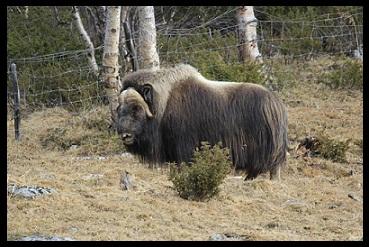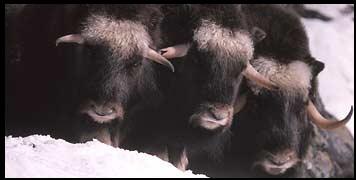The wild musk ox (Ovibos moschatus) in Scandinavian has a high level of inbreeding, because they are descends from only 10 individuals, transported from Greenland to Norway in 1953. In 1971, five musk oxen were established in Sweden, these five animals were related to today’s living animals. There are seven musk ox individuals in the wild today (Alendal, 1973; Alendal and Heller, 1983; Bretten, 1990; Groves, 1992; Klein, 1988; Laikre, et al., 1997; Lent, 1999; Lundh, N.G., 1992; Lønø, 1960). Genetic variation can in the future be provided by metapopulation managements for the Swedish wild musk ox population. The metapopulation consist isolated and small populations with genetically viable. Exchange between animals in captivity and wild population can increase the genetic variation (Groom, et al., 2006; Wikramanayake, et al., 2004; Yuttham, et al., 2003). A direct replace of the animals can be used from wild-to-wild (an animal from one wild population move to another wild population). Replacing can cause problems in form of transmission and contamination of diseases between populations. The transport from captivity to wild respectively wild to captivity is safer because every animal is investigated in order to discover different disease before transporting to new populations. The metapopulation management is a program, which is dynamic, in form of genetic information of all musk ox both in captivity and in wild are registered in a breeding program. This program prevents inbreeding for example by genetic information and location about every musk ox, is used by different facilities when planning breeding (McCullogh, et al., 1996).
One possibility to become a higher success of reintroduction of musk ox in captivity to wild is to increase their body condition before transportation. It was shown that “Willy” was not prepared enough for wildlife. He had lived in captivity too long and the season for the reintroduction was not optimal (Bengt Röken and Torsten Möller). One way to increase the body condition of captive animals is to increase their activity, which can be an area problem. The average size core areas in wild musk ox are changed under the season, in summer the animal can move in an area of 223 km², compared to during calving or winter season the area is only 27-70 km². The average movement is also changing under the seasons, in the summer it is 10 km/day and during the calving or winter period it is 0.66 km/day (Jingfors, 1982; Lent, 1988; Reynolds, et al. 1998).
The musk oxen activity is also dependent on the weather and the temperature. In the summer the animals are more active than during winter season. In the summer they construct fat reserves before the winter period. During this period the animals are inactive because of their problems with finding food under the snow; their hoofs are not formed to dig in deep snow (Jingfors, 1982; Reynolds, et al. 1998). Musk ox are normally well adapted to digesting low quality food and maintaining mass at low rate of intake under the long arctic winter period (Adamczewski, et al., 1994; Jingfors, 1982; Staaland and Thing, 1991). In order to survive the long arctic winters, the musk ox has thick under wool that protects them against temperatures below -40 C°. In the summer the wool becomes a problem, especially for the captive animals which can get difficulties to find any area to cool down in (Crater and Barboza, 2007; Munn and Barboza, 2007; Ytrehus et al, 2008).
The increasing of the activity of the musk ox improves their hoof status, if the substrate is right. A hoof is growing normally about 0.6-0.9 cm/month (Hahn, et al., 1986; Lewis, 1995), sometime faster because of high quality of food, decreasing activity or absence of abrasive surface, which can occur in captivity (Clauss and Kiefer, 2003; Groves, 1992; Liesegang, et al., 2001; Marma, 1972). The Zoo animals can develop serious hoof problem, which can affect the way the animals walk. This requires regularly veterinarian examination, avoiding the hoof to break off which is very painful and can make the animal lame (Blowey, 2005; Clauss and Kiefer, 2003; Groves, 1992; Manson and Leaver, 1989). There have been observations that the musk ox in the wild has better hoof status, compared to captive ones. This can be proved by “Willy” which lived in the wild for a short period, where an autopsy of him showed that the hoofs status had get improved compared to when he lived in captivity. The main reasons were the chancing of substrate and the increasing of activity (Bengt Röken).
The aim of the study was to investigate the musk ox activity in relation to the size and shape of the enclosure, as well as if changing of feeding and watering places can increase the activity of the musk ox, and thereby improve their hoof status. These measures could lead to a better reintroduction of musk ox into an established wild population in the future.


